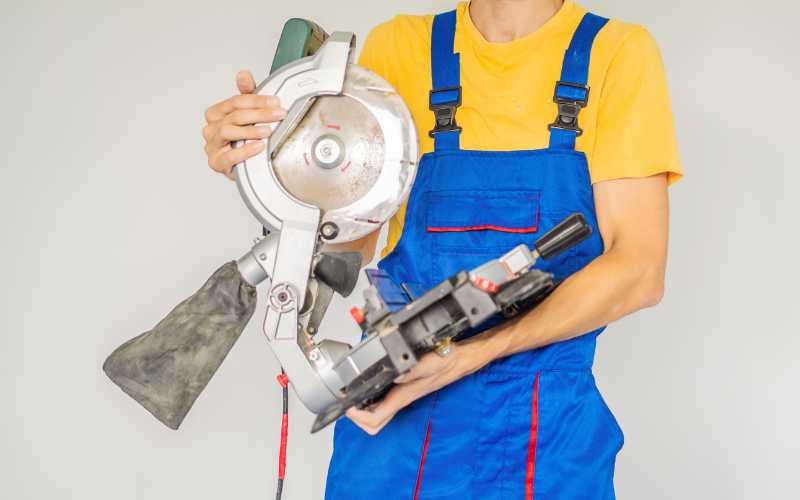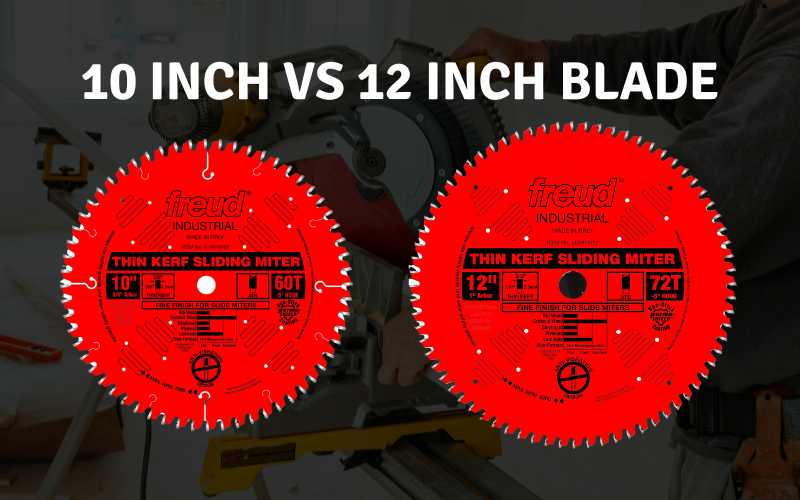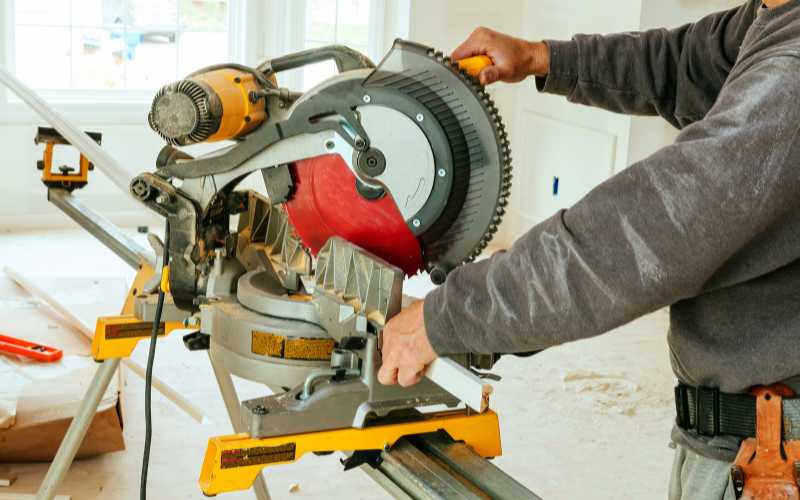If you’re thinking about buying a new miter saw, one choice you’ll have to make is whether to go for a 10-inch blade miter saw or a 12-inch unit.
Although there are other blade sizes, like 7-1/4 inches and 8-1/2 inches, the two most common blade sizes you’ll find for miter saws are 10 inches (250mm) and 12 inches (300mm).
These are the ones consumers always go for, and that’s why many manufacturers mainly produce these 2.
The question, however, is which one should you get out of the two? Which one is the better one for your projects?
Well, to answer these questions, we’ll have to look at the differences between the two blade sizes and the type of projects they’re suitable for, so that you can gain a better understanding of both and hence make the right choice.
First, let’s look at their cut capacity.
Table of Contents
Cut capacity

The major difference between the two blade types is their cut capacity. The 12-inch blade miter saw is obviously larger in diameter by 2 inches than the 10-inch blade.
As a result of that, the 12-inch does have a higher cut capacity than a standard 10-inch unit. A 12-inch can be used to cut 4×4 boards in one pass without flipping the board over to complete the cut.
A 10-inch, on the other hand, cannot be used to cut a 4×4 lumber in one pass. The board must be flipped to the other side to complete the cut.
At the end of the day, you can still use a 10-inch blade miter saw to carry out the same projects. It’s just that you have to flip your material twice, maybe thrice, which will take you more time.
With a 12-inch blade, you have to fire up your saw blade once and cut through in one pass. In this aspect, a 12-inch saw is relatively easier to use and will make you carry out your projects faster.
Weight Difference

Place a 12-inch blade miter saw side by side with a 10-inch unit, you’ll quickly find out that one is considerably larger than the other.
The bigger blade will require a bigger motor, a bigger arbor, a blade guard, a base or table, and so on, making it heavier.
Because it’s heavier, carrying it around will not be easy. For instance, the Dewalt DW713 which is a 10-inch saw weighs just 31 lbs. Whereas the 12-inch Dewalt DWS780 weighs up to 56 lbs. That’s an additional 25 lbs added to the DWS780.
If you’re a contractor or a handyman that needs something light and portable to carry along with you from jobsite to jobsite, which one would you prefer?
Some will go for the 10-inch because it’s lighter and more portable. You can carry it around easily without breaking your back.
Others, however, will still go for the 12 inches because of the added features it has, the higher cut capacity, and the power it possesses. You just have to buy a suitable roller stand to go with it, like the Bosch gravity-rise stand.
If you’re not a contractor or handyman, but instead you’re just a workshop owner that needs a dedicated miter saw in the workshop for carrying out projects, then you can just go for the 12-inch saw because you don’t need to consider the weight anymore.
It can just be placed in a dedicated space in the workshop without being moved ever.
Price
Even without being told, it’s pretty apparent that the bigger 12-inch blade miter saw is more expensive than a 10 inch unit.
That means price is surely a factor you must consider when deciding between the two. 10-inch saws are relatively cheaper, sometimes with a difference of up to 100 or even over 200 bucks. The fact, however, is you get what you pay for.
Of course, it requires more materials, a bigger motor, and a bigger blade to make one of them, and that’s why you’re spending more to get it if that’s what you need for your projects.
Cost of replacing the blade

12-inch miter saw blades are more expensive than 10-inch blades. So, if you want to replace the blade, if it’s 12 inches, you know you’re spending more to get a new one.
Power
Since it’s a bigger blade, 12-inch miter saws usually come with a more powerful motor designed to spin it and cut wider materials.
That’s not to say the motor in a 10-inch saw is not powerful. It is. However, with a bigger machine, you obviously get a bigger motor to do work.
Related: 15 Miter Saw Accessories To Upgrade Your Saw
Conclusion – Which one should you get?
Now that we know the main differences between the two, it’s now up to you to make your choice.
Personally, I believe it depends on the type of projects you plan to carry out with it. If you’re a homeowner or hobbyist trying to carry out some simple woodworking projects around the home, a 10-inch blade miter saw will do just fine.
On the other hand, if you’re a professional contractor looking for a portable unit to carry along with you on the job, a 10-inch saw will also get the job done.
However, if you’re a professional woodworker looking for a dedicated machine for use in your workshop, you can’t go wrong with a 12-inch blade miter saw.

